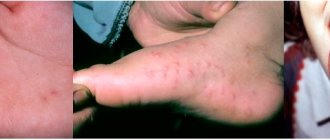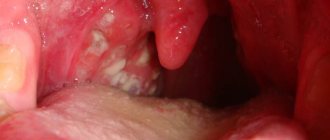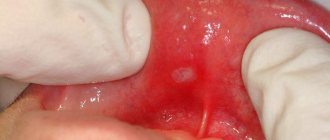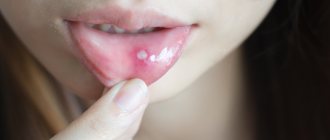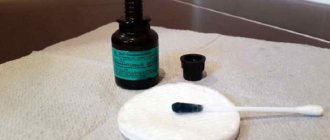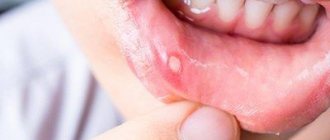- home
- Articles
- Treatment of stomatitis in the mouth in adults and children
Damage to the mucous membranes of the mouth is called stomatitis. The disease can occur in several types, each of which requires a special type of treatment. That is why you cannot take any medications on your own, since the incorrect selection of medications will only aggravate the course of the disease.
What it is
This type of stomatitis is provoked by enteroviruses entering the body. The very concept of “enterovirus” unites a large number of viral infections that actively multiply in the human gastrointestinal tract when they enter it with water, with agricultural products or from animal carriers. The virus can also be transmitted through blood-sucking insects, entering directly into the blood and ultimately leading to the development of vesicular stomatitis.
Due to their increased resistance to high acidity, detergents and even chlorine in running water, enteroviruses can survive in unboiled milk and cold-leavened dairy products, on the surface of vegetables, fruits and herbs for up to three to four months. The only way to combat them is heat treatment at a temperature of at least fifty degrees.
Enteroviral stomatitis does not occur in all people who become ill under the influence of this group of viruses, however, the occurrence of vesicular inflammation during enterovirus infection is far from uncommon, especially if there are microdamages to the mucous membrane in the oral cavity.
Symptoms of stomatitis
You can determine the onset of the disease with the naked eye by examining the oral cavity.
In patients of different ages, stomatitis manifests itself with the following symptoms:
- The mucous membrane becomes covered with aphthae-ulcers. They may also appear on the tongue.
- It becomes painful for the patient to eat and drink due to irritated mucous membranes, and children become restless and cry constantly.
- Most often there is a fever (up to about 38 degrees).
- The patient complains of a constant feeling of pain and burning in the mouth.
For quick and proper treatment of stomatitis, you need to visit a doctor immediately after detecting the initial symptoms of illness. In some immunocompromised patients, the disease progresses rapidly and can cause blood poisoning.
Causes
Enteroviruses themselves exist everywhere, and it is impossible for humans to avoid encountering them. However, these viruses do not provoke disease in all people, much less the formation of vesicular stomatitis. The most important prerequisite for its onset is a reduced level of the body’s resistance to infections due to weakened immunity.
Main methods of infection:
- airborne droplets (when talking to a carrier, sneezing, coughing);
- contact (through common objects);
- fecal-oral (when the virus gets from manure used for fertilizer onto vegetables, herbs and fruits).
The main viral agents that can be called vesicular stomatitis viruses are enterovirus 71 and Coxsackie viruses.
The risk of the disease in adults is very small; children in the first two to three years of life mainly suffer from this complication of enterovirus infection. Peaks of incidence occur in autumn and spring, and in warmer countries the risk of getting sick increases from mid-summer, since with high air temperatures and high humidity, the lifespan of the virus outside the host’s body increases greatly.
Treatment of vesicular stomatitis
When treating vesicular stomatitis, symptomatic therapy is prescribed, including:
- drinking plenty of water;
- complete rest;
- treatment of the oral mucosa with antiseptic solutions;
- taking antipyretic drugs;
- the use of antiviral ointments (oxolinic, redoxol, tebrofen).
As a rule, vesicular stomatitis does not cause complications, and signs of the disease quickly go away if the patient strictly follows the doctor’s instructions.
A childhood viral disease is also treated quite quickly and goes away without a trace if you see a dentist on time. As a medicine, the doctor may recommend taking an immunomodulator, which will help cope with the disease and will be an excellent prophylactic for the prevention of other viral diseases.
Treatment of vesicular stomatitis of the enteroviral type is generally carried out in the same ways as usual, that is, it is symptomatic. The disease cannot be neglected, as there is a risk of developing such serious complications as meningitis, encephalitis and acute flaccid paresis.
Another important point in the treatment of vesicular stomatitis in children is the isolation of children from the group so that the disease is not transmitted to others. And do not forget that hygiene items (in particular, a towel) must be individual.
Symptoms
Most often, the disease caused by enteroviruses is asymptomatic, but some patients (up to three percent of all infected) experience serious complications. The most common of them is enteroviral vesicular stomatitis with exanthema, i.e. rashes (grayish-white vesicles) localized on the palms, soles and mouth (on the inner surface of the cheeks, on the lips, tongue and even in the throat). It is thanks to this localization of the rash that vesicular stomatitis with exanthema received another name, often used among the people - “arm, leg, mouth” syndrome.
In addition to the characteristic rash with severe itching, increased salivation and pain when swallowing, this disease may be accompanied by increased body temperature and fever, weakness, chills, muscle pain, hyperemia and swelling of the soft tissues of the oral cavity, headaches and pain in the gastrointestinal tract, nausea, vomiting or diarrhea, runny nose and sore throat, and photophobia.
Since rashes appear later than other symptoms, clinic doctors often make the wrong diagnosis: acute respiratory infections, acute respiratory viral infections, allergies, dermatitis, rotavirus infection, herpes, and even simple teething. Accordingly, medications are prescribed that eliminate some of the symptoms, but blur the picture of the underlying disease.
In fact, with a fairly mild course of the disease, no specific treatment for enteroviral vesicular stomatitis is required. The first signs appear five to six days after infection, blisters appear around the third day, and after seven to ten days the patient fully recovers.
The incubation period for this infection can vary from a couple of days to a week. In the initial stages of the disease, the infectiousness of the infected person is much higher than in recent days, however, the elimination of enterovirus in feces can continue for up to a month after the onset of the disease.
Hand-foot-mouth syndrome or enteroviral vesicular stomatitis with exanthema
These viruses are quite widespread among the population, but most often affect children under 5 years of age. The disease is more common in the spring-autumn period, sometimes there is a seasonal increase in incidence upon the return of children after vacationing from southern resorts. The infection is transmitted by airborne droplets, and also has a fecal-oral transmission mechanism, i.e. In addition to sneezing and coughing, transmission factors can include toys, dishes and household items.
Viruses of this family are quite stable in the external environment - they can remain viable at room temperature for up to 2 weeks.
This is an acute infectious disease caused by RNA viruses of the picornavirus family: Coxsackie viruses A16, A5, A10, A9, B1, B3 and enterovirus 71.
Based on the characteristic clinical picture, the disease is called “hand-foot-mouth” syndrome (or enteroviral vesicular stomatitis with exanthema) derived from the English Hand-Foot-and-Mouth Disease (HFMD) and is a symptom complex consisting of lesions of the oral mucosa - enanthema and the appearance of a rash on the upper and lower extremities - exanthema.
The incubation period lasts from several days to 1 week. The first manifestations of the disease are an increase in temperature to 37.5-38.5 degrees, a feeling of malaise, weakness, headache, and sore throat. These symptoms persist for several days and are very similar to the symptoms of any ARVI. But unlike ARVI, after 1-2 days on the skin of the hands, palms, and soles; somewhat less frequently, a rash appears on the thighs and forearms in the form of vesicles with transparent contents against a red-pink background. The vesicles are generally the size of a match head. Similar rashes appear in the mouth area and in the oral cavity itself - they are in the nature of microulcers (ulcers), painful and sensitive to contrasting foods. All eruptive elements tend to reverse within a few days.
Resolving rashes in the area of the palms and soles can leave quite pronounced peeling for some time and, what is typical, some patients experience peeling and cracking of the nail plates (onychodystrophy) after a short amount of time, which is especially frightening for parents and often serves as a reason to look for a fungal infection . These manifestations are also completely reversible.
The prognosis of the disease is most often favorable. Spontaneous recovery occurs. It is necessary to isolate the child from other children, because it is extremely contagious for children's groups. All therapy comes down to symptomatic drugs (antipyretics, antihistamines), local solutions of aniline dyes for vesicles (Fukortsin), rinsing the mouth with weak solutions of antiseptics (miramistin, chamomile decoction), drinking plenty of fluids and a gentle diet is recommended. However, rarely, complications such as the development of meningitis and encephalitis are possible. Alarming symptoms of “hand-foot-mouth” disease, which will allow you to suspect an unfavorable course of the disease and require an urgent call to a doctor: fever above 39º, persistent high temperature, vomiting (sometimes multiple times), increased headache, pain in the eyeballs, constant crying and capriciousness of the child against the background of fever, constant drowsiness or, conversely, psychomotor agitation of the patient. If such symptoms appear, you should immediately call emergency medical help.
If you suspect hand-foot-mouth syndrome, you can always consult pediatricians, infectious disease specialists and dermatologists at the clinic by phone / +7 495 735-88-77
or make an appointment via the feedback form
Yours sincerely,
Dermatologist A.Yu. Putintsev
How to treat
Since a sick child is contagious to the entire group of children (adults are least susceptible to the disease), the first step is to isolate him from other children. If you find rashes on the oral mucosa, you need to contact your dentist, who will tell you how to treat vesicular stomatitis.
Most often, no specific treatment is prescribed. In case of increased pain, the child may be prescribed painkillers, local applications and rinses. Antiviral drugs and vitamin-mineral complexes may also be prescribed to support immunity. During the period of illness, it is necessary to carefully observe hygiene, be sure to wash your hands with soap after visiting the toilet and before eating.
Treatment methods for stomatitis in children
It is difficult to cure children on their own from inflammation of the oral mucosa, since the acute form of the disease causes severe pain and burning, children are capricious and refuse to take medications. However, this disease is recurrent, and without correct treatment it can cause serious consequences.
Measures should be taken as soon as ulcers or heterogeneity of the mucous membrane appears on the cheeks, tongue or any other part of the mouth. As a rule, the following algorithm is used to treat children:
- A diet that excludes any solid foods that can injure ulcers and aggravate inflammation on the gums and throughout the oral cavity. Also, the child should not be given hot, sour or salty foods.
- Brushing your teeth should be done very carefully, and your mouth should be rinsed daily with hydrogen peroxide, chlorhexidine or furatsilin. You can also use herbal decoctions with a calming effect (chamomile or calendula).
- When the temperature rises above 38.5 degrees, children are given antipyretic drugs (Nurofen, Panadol, Paracetamol).
- In some cases, aphthae are treated separately with antiseptic solutions. This is necessary if the mouth ulcers are large enough and cause severe discomfort. Antiseptic aerosols are convenient remedies that help relieve inflammation, but they should not be used to treat children under one year of age.
Additional therapy is prescribed depending on the form of the disease. For example, to get rid of the herpetic form, special antiviral agents are prescribed (for example, Acyclovir, which is used specifically to eliminate the herpes virus), and for the angular form, iron supplements are used, since it is impossible to replenish the supply of this mineral in the required volumes with ordinary iron-containing products (beans, nuts, apples). However, they must be included in the child’s menu after completion of treatment.
On average, the duration of treatment is 2 weeks, but if after this period the disease has not gone away, you need to consult a doctor again to adjust the treatment.
